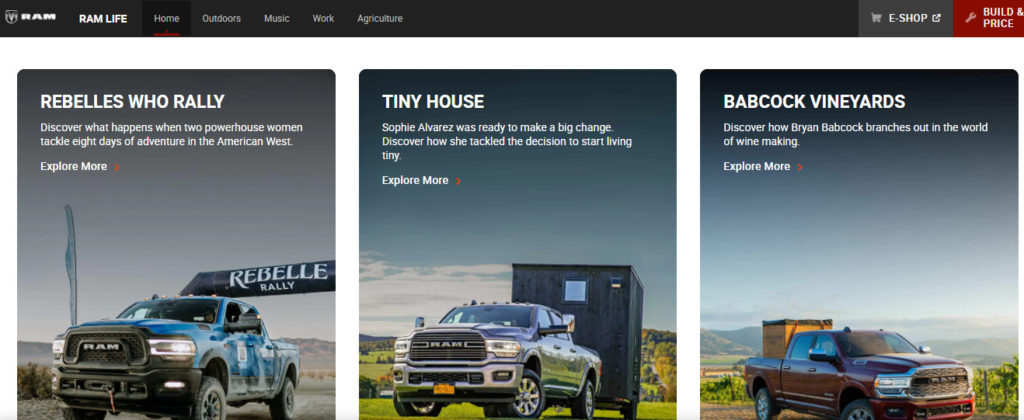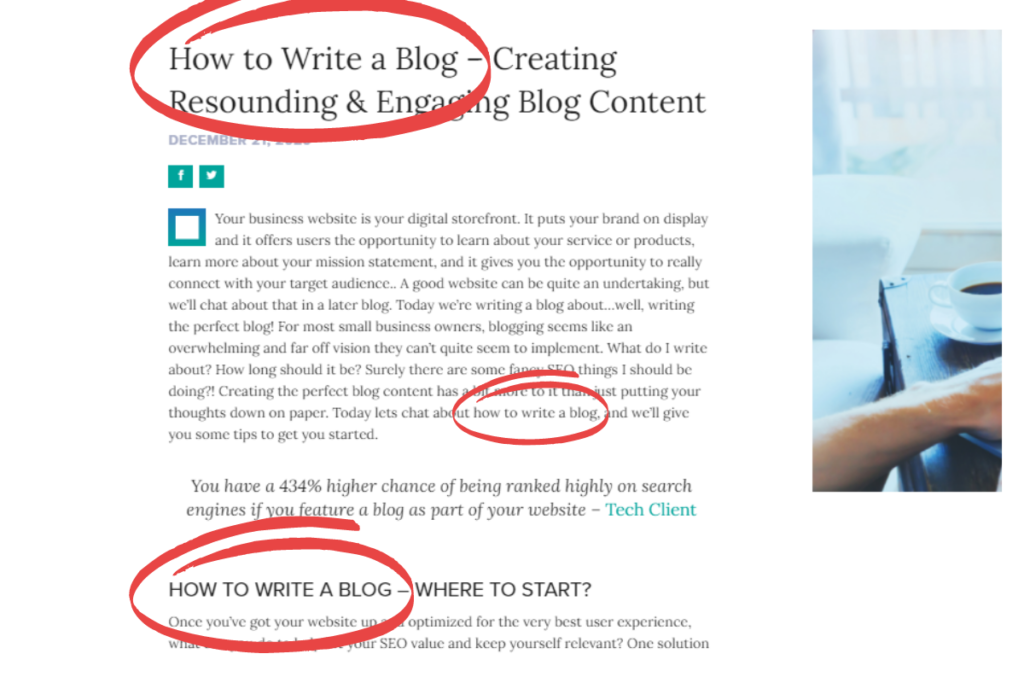Your business website is your digital storefront. It puts your brand on display and it offers users the opportunity to learn about your service or products, learn more about your mission statement, and it gives you the opportunity to really connect with your target audience.. A good website can be quite an undertaking, but we’ll chat about that in a later blog. Today we’re writing a blog about…well, writing the perfect blog! For most small business owners, blogging seems like an overwhelming and far off vision they can’t quite seem to implement. What do I write about? How long should it be? Surely there are some fancy SEO things I should be doing?! Creating the perfect blog content has a bit more to it than just putting your thoughts down on paper. Today lets chat about how to write a blog, and we’ll give you some tips to get you started.
You have a 434% higher chance of being ranked highly on search engines if you feature a blog as part of your website – Tech Client
How to Write a Blog – Where to Start?
Once you’ve got your website up and optimized for the very best user experience, what can you do to help lift your SEO value and keep yourself relevant? One solution to adding additional content that can help build on your site’s existing good (we prefer great!) SEO is the implementation of a well written blog column. A frequent conversation surrounding blog content for your website has marketing gurus everywhere debating post frequency and content type, but it’s not all about throwing some content together and slapping it up on your site. There’s incredible value in a well rounded, efficient and effective blog column, so the addition of one to your website is a solid marketing strategy.
Below we’ve laid out some important elements to consider when writing a blog post, along with some resources to help you maximize your ROI on making this time intensive addition to your marketing strategies.

Each content piece should vary in voice and intent. Blog intent and topics should relate to your product or service, such as this Dodge Ram blog column. Talk about things that apply to your product – not every piece should try to sell to your audience.
Choosing a Topic
This can sometimes be the most daunting part of the whole process. Your blog content should support your brand, your product, and your mission. The best part about a consistent and well done blog column is that it gives your users totally free, added value in the form of information. All blogs are not created equal, and your content and voice will vary based on your brand image. There are some guidelines though, when deciding what content pieces you want to write about.
94% of people who share posts do so because they think it might be helpful to others. –Ad Pushup
- Relate to your brand and product – In order to get the most out of your blog content, be sure you’re speaking either directly about your brand or products and services, or about things that relate to them. If you own an apple orchard, your content can include a wide variety of apple related content like apple recipes, apple history, growing apples, etc. You probably don’t want to write blog pieces about, say, woodworking, unless your woodworking directly relates to your apple growing business.
- Keyword research – If your business employs google ads, don’t forget to do keyword research via their keyword tools. There are free tools out there that can help you identify keywords and phrases that people are actually searching for. How does this help? It shows search engines that you have content that people are actively searching for, and if your content is good both in SEO value and information, it’ll help your page climb the ranks. It’s also a good idea to do live searches to learn what keywords your competitors are using in their blog content.
- Research your topic – Good blog content includes your own experiences and knowledge, but it backs it up with relevant, and legitimate citing of sources and information. If you’re dropping a statistic, link to the source you found that piece of data right in your content. This helps search engine crawlers verify your content is legitimate, and that your information leads users to more resources that pertain to your content. It ups your page’s SEO value and further reinforces your spot in the search engine rankings.

Your blog should be conversational in nature – you can add your opinion, just make sure you back up and facts you use with sourced hyperlinks inside your content. Go wild! Brand voice in blog content matters.
Drafting Your Perfect Content Piece
Once you’ve done your research, know what keywords you need to utilize throughout your formatting, and you have reliable sources to link to, it’s time to get writing. Elements to pay attention to are content length, headers, keyword density (how often you use your target keyword or phrase in your content) and visual pieces to help flesh out your piece.
- Length – For a long time, the general consensus was that blog length should aim for 500 words, but never go below 300, and try to stay under 800, but oh how times are changing. Now, long-form blogs are performing relatively well, in moderation. It’s important to note that not all of your blog pieces should aim for long-form status. Long form blog content falls between 1,000 and 2,000 words, and as a content writer, it’s imperative that if you’re aiming for that high 2k word goal post, your blog is chock full of information. The general rule is you should aim for a few of these long-form pieces a month. These blog pieces can sometimes compound over time, and become evergreen content pieces that perform organically for you over time.
- Other important formatting elements – Blogs aren’t just to deliver your opinion or information. Using a blog column to elevate your SEO absolutely requires good SEO formatting. To achieve better rankings with your content pieces, make sure you’re using appropriate headings throughout your blog, and at least one that holds your target keyword. Break up your content into subheadings as well – it can be difficult for readers to stick with you if your piece is just one chunk of text broken up into paragraphs.

Added SEO value comes from a variety of formatting elements. Research should start with your target keywords. These keywords in y our blog should be added in the appropriate places to get optimum value. For the purpose of this blog, our target keyword or phrase is “How to write a blog”. Notice how we’ve used it in the blog title, copy, and headers.
- Visual elements – Video is king, but so are other visual pieces like infographics, charts, and images that relate to your content. Be sure that the proper alt tags are used when naming your images, and link to any sources if you’re using images or assets from another company or source.
- Tone – Your blog should represent your brand voice, and you should use a voice that reflects your brand image. They should be conversational in nature, and while you want to educate and speak on the same level as industry professionals and experts, you also want to relate to the part of your audience that’s looking to be informed. Be genuine in your delivery and you’ll find that your followers will seek out your content the more they relate to you, and your business.
- Use internal and outbound links – Your blog should always link to both outside and internal sources. Referring back to our previous example of being an apple orchard business owner, if you’re talking about the best fertilizers for your apple trees, link to the product you use right in your content. The fun part about writing blogs is creating super positive SEO linking within your own website. Make sure you reference other blogs written by your business, or send them to another page on your site to get more information.
- Intent – This can be tough for a lot of businesses. Not every blog should be intended to drive sales – in fact, constantly pushing people to buy your product or invest in your services can turn your followers off and hurt your traffic. Don’t view your blog pieces as a direct lead generation, or as a piece used to solely drive sales. Content marketing is as much about SEO value as it is about brand awareness. If you’re writing about the very best eating apples, and you want to drop a link to ordering a case of apples from your business at the bottom, that’s totally great! If you’re writing about apple orchard care, unless you sell fertilizer, it’s not necessary to ask them to purchase said fertilizer.
- Voice your opinion! – People are reading your blog because they want to know how you think about a topic – using your opinion is perfectly acceptable in this format. Just be sure to link to sources if you’re stating information as fact!
Relate, Relate….Did We Already Say Relate?
Blogs are a fantastic way to humanize your brand by using appropriate conversational tone and to express your feelings and experiences. Don’t sell yourself short; this is your business and you should know it best. So speak your praises when you have accomplishments, share your valuable experiences about your industry, and deliver resonating information with people who are still there all the way to the bottom drinking in all that valuable information you’re giving them for free. You can do it! And what you know is absolutely valuable!
Blog posts continue to drive traffic and generate impressions up to 700 days after they go live. – Izea
It takes a lot of practice and finding your groove to perfect your blog column, but this should get your business started. Of course this blog in particular doesn’t cover every aspect of writing the best blog – that, in fact, would make our blog even longer than the max 2k word maximum for best SEO value. The good news however, is that getting started is the hardest part. It can be time consuming, so if you’re looking to get blog content up and running for your website, Capacity Marketing has an entire experienced team here to help. Give us a call at 845-430-5277 to get started. We’re ready to create engaging blog content for your site!